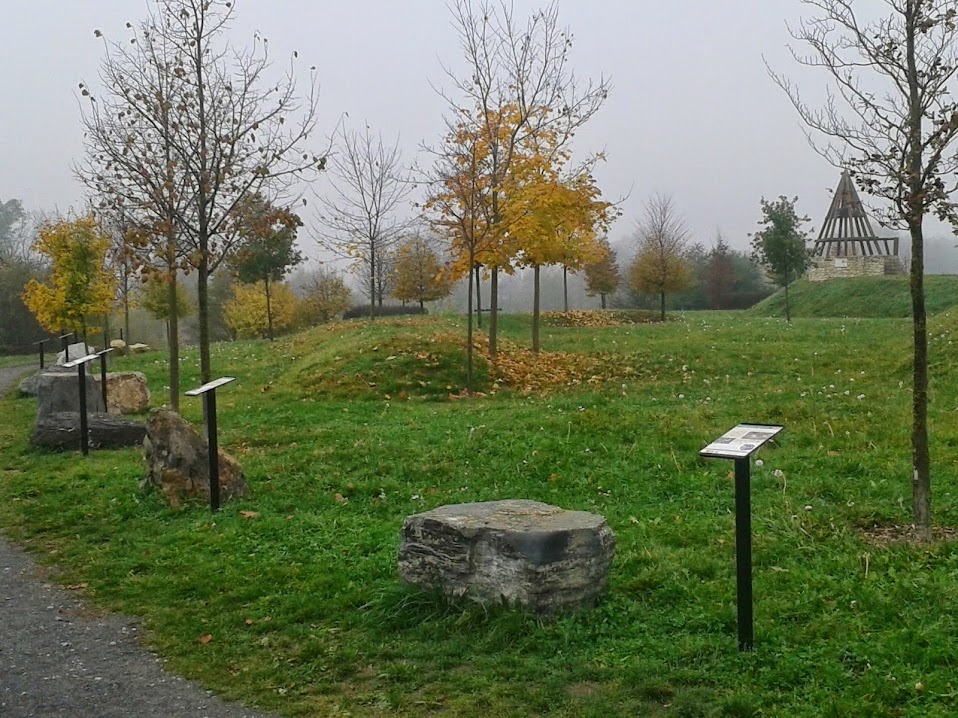Prijmete prosim pozvani do nove vybudovaneho parku s rozhlednou, pergolou, udrzovanymi cestickami, nedalekym vybehem pro kone a hlavne ukazkou hornin z ruznych koutu Prahy. U kazdeho vzorku je info tabulka, kde najdete ciselne oznaceni, stari, lokalitu nalezu a nekolik poznamek o vzniku dane horniny.
 Venkovni expozice vysla z cisteho nadseni geologicky zamerenych pracovniku v ramci grantoveho projektu Hlavniho mesta Prahy pro zlepseni zivotniho prostredi. Zahrada byla otevrena 13.9.2014.
Venkovni expozice vysla z cisteho nadseni geologicky zamerenych pracovniku v ramci grantoveho projektu Hlavniho mesta Prahy pro zlepseni zivotniho prostredi. Zahrada byla otevrena 13.9.2014.
Pristup od parkoviste je vhodny i pro vozickare. V zimnim obdobi si budete muset zpristupnit cedulky, ale co byste pro ziskani informaci a splneni earthcache neudelali, ze 
Geologicka zahrada ukazuje horniny z hlavniho mesta Prahy a jejiho blizkeho okoli. Vystavene vzorky zachycuji geologicky vyvoj v oblasti v intervalu od 600 milionu let do soucasnosti. Jsou zde horniny vznikajici vlivem rozsahle sopecne cinnosti nebo horniny, ktere vznikly v usti reky do davneho more. Dalsi vystavene vzorky pochazi z hlubokeho morskeho dna ci plaze. Vystavene vapence zase svedci o bohatem zivote v devonskych morich. Oproti tomu dve vystavene horniny jsou pripominkou rozsahle magmaticke cinnosti v hloubce nekolika kilometru srazkou dvou kontinentu pred 350 miliony let.
Pro uspesne zvladnuti teto earthcache nam zaslete spravne odpovedi na nize uvedene otazky na nas profil. Pote se zalogujte. Pokud bude neco v neporadku, ozveme se vam.
Protoze jsou informacni tabulky od postaveni teto Geologicke zahrady za roky pusobeni slunce a nenechavych navstevniku ponicene a hure citelne, menime k 16.8.2023 otazky. Odpovedi na nase otazky budete nyni hledat na protejsi strane, kde jsou cedule citelne.
1. Na horni strane vzorku c.12 vede temer stredem svetla zila mladsiho aplitu. Odhadnete jeji pribliznou siri.
2. Nejvice vas asi zaujmou vzorky c.18, ktere maji tvar zelvich krunyru. Nas bude zajimat, jak se tato sedimentarni hornina jmenuje. Pro zajimavost si muzete precist, co bylo pricinou vzniku a co obsahuji.
3. Odkud pochazi vzorek c.19 Serpentinit (hadec) a z jake hloubky pod zemskym povrchem muze pochazet?
4. Stojite pred vzorkem c.20 - Biotitovcem. Jak jsou tyto horniny obecne oznacovany? Jake je jejich priblizne stari?
5. Jak se jmenuje a cim je vyhlaseny vzorek c. 21? A jak vypada jeho typicka textura?
6. Foto vas ci GPS u nektereho ze vzorku uz neni povinne, ale jiste nas potesi.
Doufame, ze se vam prijemne upravene prostredi i nenarocna earthcache libila.
Informace cerpany z informacni cedule na uvodnich souradnicich a z internetu na Google.
-----------------------------------------------------------------------------------------------------------------------
EN
Please accept our invitation to a newly built park with a lookout, pergola, and paths, nearby paddock and especially with exhibition of rock samples from different parts of Prague. For each sample there is info table, where you'll find age of the sample, locality and some information on the formation of the particular rock.
The outdoor exhibition was created due to enthusiasm of geologically oriented enthusiasts in frame of the environmental improvement project, supported by the grant of the Capital city of Prague. The garden was opened September 13, 2014. The access from the car park is suitable for wheelchairs. In winter you will probably have to clear the signs.
The geological garden shows rock samples from territory of Prague and its close neighborhood. Rock samples records geological evolution in the interval from period of 600 million years ago to the present. There are rocks emissions from widespread volcanic activity or rock that originated in ancient river estuary to the sea. Other exposed samples come from the deep seabed or beaches. Exposed limestone is evidence of a rich life in the Devonian seas. In contrast, the two exposed rocks are results of magmatic activity at a depth of several kilometers, due to collision of two continent 350 million years ago.
To log this Earth cache, please e-mail us answers to following questions first and you can log FI. If something is wrong, we will contact you.
Because the information tables since the construction of this Geological Garden have been damaged by the sun (and unforgiving visitors) over the years, we are changing the questions as of August 16, 2023. You will now look for the answers to our questions on the opposite side, where the signs are noticeable.
1. On the upper side of sample no. 12, light veins of younger aplite run almost through the middle. You estimate its approximate width.
2. You will probably be most interested in samples no. 18, which have the shape of turtle shells. We will be interested in the name of this sedimentary rock. For the sake of interest, you can find out what was the reason for its creation and what it contains.
3. Where does sample no. 19 Serpentinite (Hadec) come from and from what depth under the earth's surface can it come from?
4. Stand in front of sample no. 20 - Biotiovec. How are these rocks generally referred to? What is their approximate age?
5. What is the name and what is sample no. 21 known for? And what does its typical texture look like?
6. Your photo or GPS (for some of the samples) is no longer mandatory, but it will certainly please us.
We hope that you have enjoyed this beautiful place and our easy Earth cache.
Source of information: tables in the garden, internet.